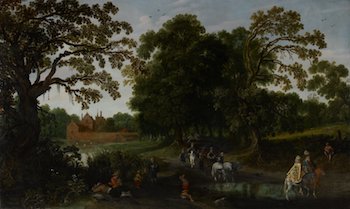Al Naylor grew up in Miles City, a former cattle town on the high plains of Montana, and became an executive atop what is now U.S. Bank in Minneapolis. He had always liked museums but disliked the hierarchies and pretensions that seemed to govern them. And so, in the mid-1980s, when he struck up a relationship with the Minneapolis Institute of Art, he was pleased to find a kinship with the curators: “They are people,” he told me recently. “They are interested in educating.”
He joined affinity groups for paintings and Asian art. He took a trip to India through the museum, led by Bob Jacobsen, the museum’s rather professorial curator of Asian art at the time. “Poor Bob had to sit next to me for 13,000 miles,” Naylor jokes. Eventually he and his wife helped launch the museum’s Adopt-a-Painting program to fund the restoration of artworks in dire need of repair.
“The average person can do this,” he says of supporting conservation. He and his wife have now rescued more than a dozen paintings.
But Naylor’s most intriguing engagement with the museum might be a thick stack of poems. He’s been writing them for years. Some short, some epic, running for pages and pages. He writes about the art in the galleries—paintings, drawings, sculpture—though he admits that some subjects inspire him more than others. “It’s hard to write about silver—there’s not much personality there,” he says, though he did write about Paul Revere, the silversmith/revolutionary behind one of the museum’s most prized pieces.
No person did as much for hay / as did the artist Claude Monet, he wrote in a poem about Monet’s Grain Stack, Sun in the Mist. But did the farmers see their hay / in quite the same way as Monet?
In a poem about Esaias van de Velde’s painting Courtly Procession Before Abstpoel Castle, called “On the Benefits of Standing on One’s Head,” he wrote, Do noblemen as they pass by / stare through you like you’re dead / or barely mask a sneer or nod a patronizing head? / They’d look a lot less regal / were you upside down instead.
Artists, he says, often “lose their humanity” when they become part of art history, their lives subsumed by their accomplishments or style. “We forget that Renoir could barely hold a brush,” he says, “that Modigliani was dissolute and druggy and died young.” Writing about their work, Naylor can get inside their heads for a while. Play around. Get reflective. And then emerge to tell others what he found. He’s even led tours of the galleries using his poems as material.
Naylor’s poetry often has the spontaneous sense of direct observation, as though he were transcribing his thoughts as he stood before an artwork or saying them out loud to a companion—you, the reader. My God! Can you imagine how / the artist stood in a pitching bow / near the coast of Noordeen-Voorland, he wrote in a recent poem about Abraham Storck’s The Four Days’ Battle.
It’s a very long tradition, writing poetry about art, and even has its own ancient moniker: ekphrasis. Plato and others encouraged it as a rhetorical exercise, to try describing what could not be seen in an artwork in order to elevate the original—and perhaps surpass it. But Naylor isn’t into it for himself. He hopes his poems are their own form of inspiration. “A demonstration,” he says, “that everyone can see something different from someone else.”
Here, for your National Poetry Month pleasure, is Naylor’s full poem about Monet’s Grain Stack, Sun in the Mist:
No person did as much for hay
as did the artist Claude Monet
who pictured stacks at evening’s glow,
in autumn heat or ‘neath the snow.
No hay was ever commonplace
when captured in his frame’s embrace.
But did the farmers see their hay
in quite the same way as Monet?
What are the odds they saw the art
in that which made their muscles smart
when lifting what a reaper mows
so as to feed but hungry cows?
What did they think to see him there,
his brush aflutter in plain air,
to see him glamorize a pile
of stuff which makes but charbrays smile,
or Friesians or Fribourg bulls?
Did they too feel the little pulls
of beauty on their senses while
surveying what their craft had wiled,
or but the tug of other chores
which nagged them as they toiled outdoors?
It might be hard for art’s allure
to move those shoveling manure.
And yet we marvel at the hues
which populate these grainstack views,
and learn from them to teach our eye
to savor what once passed us by
in landscapes which, though cherished dearly,
are seen by artists far more clearly.



